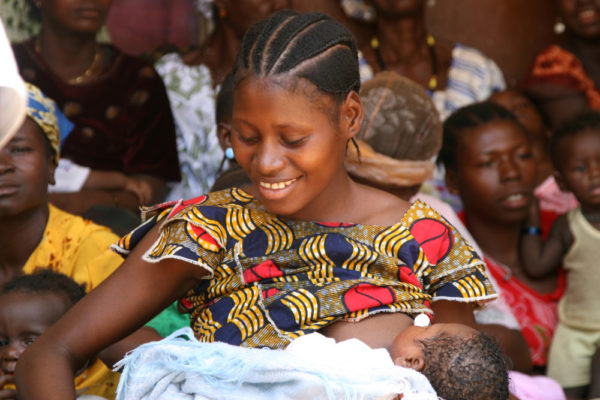Features
Dr. Chinny Obinwanne: Is The Hype About Breastfeeding Really Worth It?
 I recently heard from a mother that there is barely any difference between breastmilk and formula, and that all of the breastmilk hype is false.
I recently heard from a mother that there is barely any difference between breastmilk and formula, and that all of the breastmilk hype is false.
According to research, Nigeria is one of the top 3 countries with the highest number of newborn mortality rates worldwide. These are babies that die within the first 28 days (newborn period) of birth
The care of a newborn begins from pregnancy. The mother’s health and her nutritional intake have a great impact on the growth and survival of the baby.
After birth, breastmilk is the baby’s first vaccine, which gives the best protection against illnesses and diseases. During pregnancy is when an expecting mother has the opportunity to learn more about breastfeeding, so that she may kickstart breastfeeding immediately after delivery.
The advantages of breastfeeding are numerous. Breast milk is ultimately the best source of nutrition for a new baby. Many components in breast milk help protect your baby against infections and diseases, especially in those early days. The proteins in breast milk are more easily digested than in formula milk. The calcium and iron in breast milk are also more easily absorbed.
So let’s analyze breastmilk. Is it really worth it? Is it really befitting the title liquid gold?
Breastmilk contains the perfect combination of protein. At the newborn period, breastmilk contains 90% of whey protein and 10% of casein protein, and this changes to 60% and 40% respectively afterwards. Whey protein is easy on the bowel of a newborn so its easily digested, providing constant nutrient to the baby. Formula has more casein to whey ratio. The importance of whey protein lies on its immunological defense components which include
- Lactoferrin.
- Alpha-lactalbumin.
- Serum albumin.
- Immunoglobulins.
- Lysozyme.
These might sound like jargons to you. All you need to know is that these components equip your newborn to fight a host of infections, giving your newborn a 90% chance at survival.
Breastmilk also contains fat, which provides about half of the calories for your baby’s daily needs. Hindmilk, which is the milk at the end of feeding, contains twice the amount of fat compared to foremilk, the milk at the beginning of feeding. Fat in breastmilk is also responsible for the higher visual acuity and cognitive ability of a child, promoting a healthy neurological growth.
Breastmilk contains vitamins and micronutrients. The amount of this in milk varies amongst mothers as it is dependent on diet and genetic background. Vitamin A is necessary for vision development, Vitamin D which is for bone growth is available in a little amount in breastmilk, so baby needs an additional daily intake, Vitamin E is an antioxidant, protecting the cells from injury, Vitamin K is required for blood clotting factors preventing bleeding.
Breastmilk also contains water-soluble vitamins, and these are very much reliant on the mother’s diet. If a mom is having a healthy diet she will have enough water-soluble vitamins in her milk. Breastmilk also contains minerals such as sodium, zinc, Iron (this is present in small amounts but the baby has built a reserve from the womb), calcium, magnesium, and more.
Breastmilk contains carbohydrate, which is mostly from lactose. The more frequent a baby feeds the more the lactose produced. This provides 40% of the calories needed by the baby. It also enhances calcium absorption, provides energy to the brain, and promotes the growth of lactobacillus, which is a probiotic.
Probiotics, which are living microorganisms, colonize the oral cavity of breastfed babies more frequently than formula fed babies. Breastmilk contains white blood cells, living cells that respond to infection by attacking and killing the foreign cells and bacteria.
Breastmilk contains antibodies and immunoglobulins, which provide important immunological protection for your baby, especially in the digestive tract, which is the point of first entry of bacteria.
Breastmilk contains 88% water, and this is more than enough water for your baby. The milk at the beginning of feeds has more water and helps quench thirst in babies.
There is a lot in breastmilk. I tried counting the components myself and I counted over 200. And I’m still counting! More than half of it cannot be manufactured.
In summary, breastmilk contains water, carbohydrate, protein, nonprotein nitrogens, amino acids, nucleotides, antimicrobial factors, enzymes, hormones, peptides, cytokines, vitamins, minerals, sterol, sphingolipids, phospholipids, triglycerides, etc.…. These all have a lot of components under them.
Is breastfeeding overrated? Please be the judge.
I will end by saying: Breastmilk is a mother-made wonder food. It cannot be replicated. With all that is loaded in it, every drop counts, and whatever the quantity is, it can always be worked on to produce more.
Photo Credit: © Feije Riemersma | Dreamstime.com























